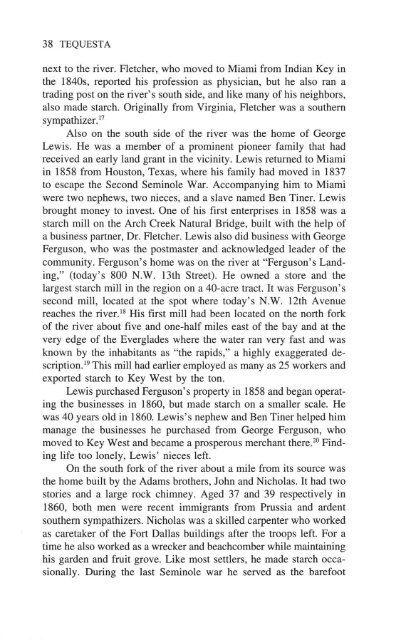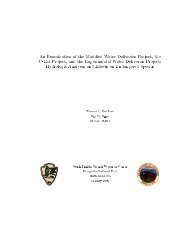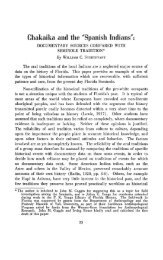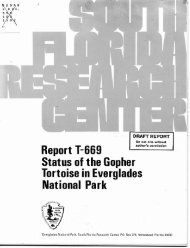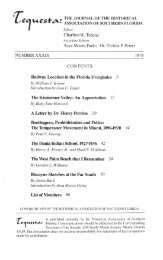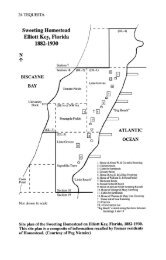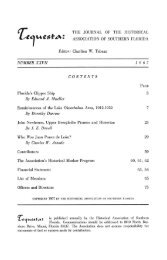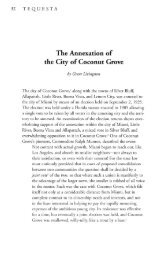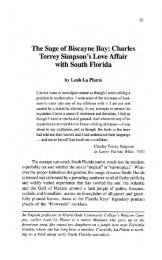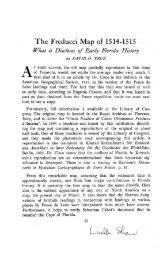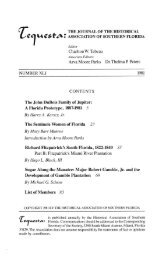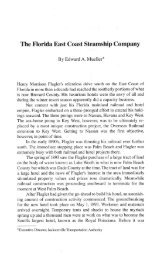Miami During the Civil War - FIU Digital Collections
Miami During the Civil War - FIU Digital Collections
Miami During the Civil War - FIU Digital Collections
You also want an ePaper? Increase the reach of your titles
YUMPU automatically turns print PDFs into web optimized ePapers that Google loves.
38 TEQUESTA<br />
next to <strong>the</strong> river. Fletcher, who moved to <strong>Miami</strong> from Indian Key in<br />
<strong>the</strong> 1840s, reported his profession as physician, but he also ran a<br />
trading post on <strong>the</strong> river's south side, and like many of his neighbors,<br />
also made starch. Originally from Virginia, Fletcher was a sou<strong>the</strong>rn<br />
sympathizer. 17<br />
Also on <strong>the</strong> south side of <strong>the</strong> river was <strong>the</strong> home of George<br />
Lewis. He was a member of a prominent pioneer family that had<br />
received an early land grant in <strong>the</strong> vicinity. Lewis returned to <strong>Miami</strong><br />
in 1858 from Houston, Texas, where his family had moved in 1837<br />
to escape <strong>the</strong> Second Seminole <strong>War</strong>. Accompanying him to <strong>Miami</strong><br />
were two nephews, two nieces, and a slave named Ben Tiner. Lewis<br />
brought money to invest. One of his first enterprises in 1858 was a<br />
starch mill on <strong>the</strong> Arch Creek Natural Bridge, built with <strong>the</strong> help of<br />
a business partner, Dr. Fletcher. Lewis also did business with George<br />
Ferguson, who was <strong>the</strong> postmaster and acknowledged leader of <strong>the</strong><br />
community. Ferguson's home was on <strong>the</strong> river at "Ferguson's Landing,"<br />
(today's 800 N.W. 13th Street). He owned a store and <strong>the</strong><br />
largest starch mill in <strong>the</strong> region on a 40-acre tract. It was Ferguson's<br />
second mill, located at <strong>the</strong> spot where today's N.W. 12th Avenue<br />
reaches <strong>the</strong> river. 18 His first mill had been located on <strong>the</strong> north fork<br />
of <strong>the</strong> river about five and one-half miles east of <strong>the</strong> bay and at <strong>the</strong><br />
very edge of <strong>the</strong> Everglades where <strong>the</strong> water ran very fast and was<br />
known by <strong>the</strong> inhabitants as "<strong>the</strong> rapids," a highly exaggerated description.19<br />
This mill had earlier employed as many as 25 workers and<br />
exported starch to Key West by <strong>the</strong> ton.<br />
Lewis purchased Ferguson's property in 1858 and began operating<br />
<strong>the</strong> businesses in 1860, but made starch on a smaller scale. He<br />
was 40 years old in 1860. Lewis's nephew and Ben Tiner helped him<br />
manage <strong>the</strong> businesses he purchased from George Ferguson, who<br />
moved to Key West and became a prosperous merchant <strong>the</strong>re. 20 Finding<br />
life too lonely, Lewis' nieces left.<br />
On <strong>the</strong> south fork of <strong>the</strong> river about a mile from its source was<br />
<strong>the</strong> home built by <strong>the</strong> Adams bro<strong>the</strong>rs, John and Nicholas. It had two<br />
stories and a large rock chimney. Aged 37 and 39 respectively in<br />
1860, both men were recent immigrants from Prussia and ardent<br />
sou<strong>the</strong>rn sympathizers. Nicholas was a skilled carpenter who worked<br />
as caretaker of <strong>the</strong> Fort Dallas buildings after <strong>the</strong> troops left. For a<br />
time he also worked as a wrecker and beachcomber while maintaining<br />
his garden and fruit grove. Like most settlers, he made starch occasionally.<br />
<strong>During</strong> <strong>the</strong> last Seminole war he served as <strong>the</strong> barefoot


